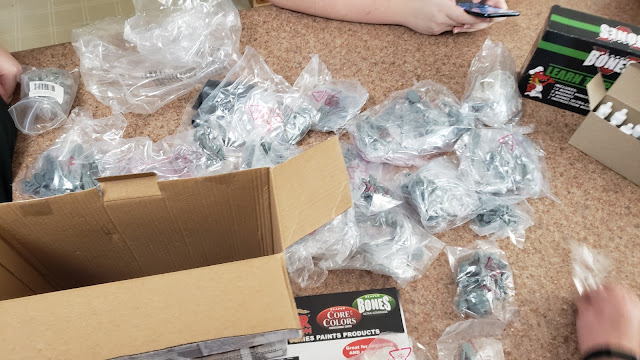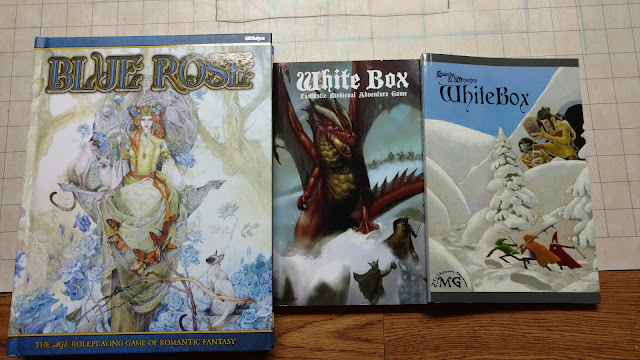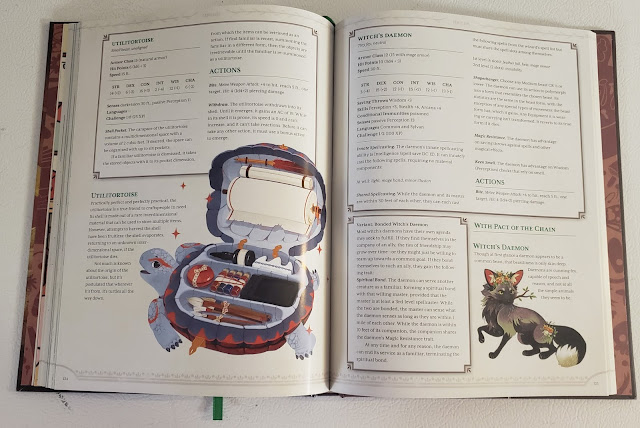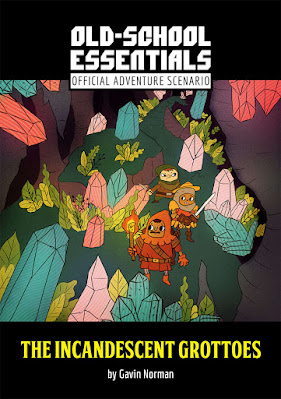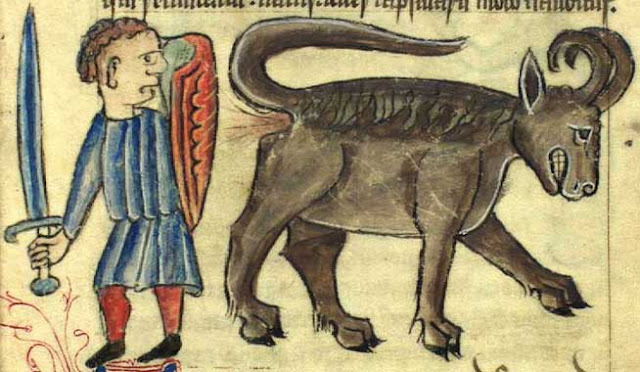Are you a fan of Studio Ghibli movies? Well, I am and the authors of Witch+Craft, a 5e crafting supplemental are as well. And this book proudly and openly displays that love. But I am getting a little ahead of myself.
I backed this project as a Kickstarter a while back and it came with the book, PDFs, and all sorts of great add-ons like wallpapers and spell and magic-item cards (PDFs).
So I am going to be reviewing the hardcover book and the PDFs from the Kickstarter. I am uncertain if the PDFs from DriveThruRPG are 100% the same or not.
You can purchase the hardcover from the publisher's website and the PDFs from DriveThruRPG or also from the publisher.
Witch+Craft, a 5e Crafting Supplemental
Witch+Craft is a full-color hardcover 214-page book. The theme of the book is decidedly high magic, and a style of high magic infuses all aspects of the lives of the people of this particular vision of the 5e fantasy universe. This book is exactly the opposite of "grimdark," wherein magic is everywhere and it is a tool to be used to make things better. I state this upfront because that is the pervasive philosophy of the book. It works, and it is a great one to have. But it will have to fit your style of gaming and campaigns. I knew this on the onset, and lets be honest, the cover gives this away, but if this is not your kind of game there is not a lot (there is some!) that this book can give you.
That all being said this book is a fantastic resource for anyone that has ever said "can I use magic to make BLANK?" Where BLANK is anything and everything from clothes that clean themselves, to self-sorting spell components, to fire that heats but won't burn, to well...half a thousand things I have heard from my kids in their 5e games.
While I may have started this review with who this book is not for, who it absolutely IS for is anyone that has ever played an Artificer in 5e or an Alchemist in Pathfinder 2e.
What this book doesn't have, despite the name, is a Witch class. Ah well.
Introduction
We get the basics of this book. In bold letters right in the first line of the first paragraph we get :
This book is about making things.
You have to appreciate this. Some RPG books are never quite as clear as to what they are about. This book is also about rounding out your character with Trade Classes. Though Trade Professions would likely be a better term. You can take these along with your Fighter, Wizard, or whatever levels. I will get into more details in a bit.
Chapter 1: Domestic Magic
Part 1 of this chapter covers the basics of crafting. The six-step process is listed and then detailed.
- Blueprint. You propose a project.
- Challenges. The GM imposes a Difficulty Level based on the specifications of the project. They will also list the base materials required to make the crafting attempt at all. (7 levels total)
- Preparation. You may prepare for the project in order to improve your chances of success.
- Craft Action. You begin the project, rolling to qualify your success.
- Fine-tuning. After the rolls are in, you may choose to expend bonuses to alleviate any potential flaws.
- Appraising. When all is said and done, the item is created, and its features and flaws known.
The rules here a pretty simple and even elegant in their own ways. It does add to the 5e system as a new sub-system. So while old schoolers will not even blink an eye it does feel "added on." Now this is not a bad thing. It feels like the best system for detailed craftwork, as opposed to say "just roll a d20 and beat this DC."
Part 2 deals with Trade Class basics. This is just a tracking system on how you get better with crafting. Class is kind of a misnomer here since it is not a D&D Class. Trade Profession might have been a better choice. These professions/classes can progress through Tiers (not levels) and have different kinds of media they work in; crystals, drafting, living arts, metals, textiles, and wood.
Part 3 covers Techniques. Or how you can do things. This also covers tools. They are presented like feats but are attached to the Tiers. For example "Green Thumb" does more or less what you think it does. The prereq is "Living Arts or Wood." While presented like a feat, it does not have any "combat" advantages. Certainly lots of role-playing advantages.
Part 4 is Picking Your Trade Class. Here are the actual classes/professions. They are based around the media above. So someone that works with crystals could be Glass Blower or a Mason or a Jeweler. The builds cover what other materials you can work with, what tools you have, and starting techniques. Each media get three example builds.
Chapter 2: Cape Verdigris
Cape Verdigris is a setting where all of this crafting and domestic magic can be seen in use. It lists places of interest, guilds, shops, and many major NPCs. It is designed to be added to pretty much any campaign world.
Chapter 3: A House of Plenty
This is a 40-page complete adventure of a different sort. The goal here is to restore an old manor house to it's former glory using the crafting skills they have learned in this book. So in TV shows, you are trading Sci-Fi or Shudder for HGTV. There is something interesting here and I really admire the authors' choices here.
Chapter 4: Spells
This chapter covers 12 new spells to use in conjunction with the rules.
Chapter 5: Familiars
Also what it says on the cover, this introduces 10 new familiars. Many are fey, others are animals. Greater familiars are also presented here. If you wanted a soot familiar like the ones in "My Neighbor Totoro" or "Spirited Away" then this chapter has you covered.
Chapter 6: Items
Not just magic items but a whole bunch of mundane and domestic magic items as well. The blanket of napping is an easy favorite.
Appendices
Here we get a collection of various stats.
Appendix I. The NPCs from Chapters 2 and 3 get their writeups here. Why not with the chapters? Easy, in the chapters, you are supposed to be focused on who these people are how you interact with them, NOT what their combat stats are.
Appendix II covers unusual trades like healers and wandmakers.
Appendix III has various boons and flaws of the items crafted. These can be minor, major or magical/dangerous for boons and flaws respectively.
Appendix IV is a list of crafting obstacles.
Appendix V cover crafted treasures
Appendix VI is Awakened Objects. So lots of monster stats here.
Appendix VII covers the stats of various objects; HP and AC.
There is a very attractive character sheet in back. The next few pages cover all the designers and artists that helped make this book possible. There is also a list of Kickstarter contributors. Sadly there are a few typos here with some names cut off, some listed more than once. Mine isn't even listed at all.
There is also an index and the OGL statement.
The book really fantastic and joy to look at. The art is great, the layout is wonderful and very easy on the eyes.
The audience for this book is a little slim. There is nothing in this book really that would help in combat, defeating the next big bad (unless he challenges you to a bake-off) or any of the things that people typically associate with D&D. This is much more of a narrative presentation with a lot of role-playing potential.
One of it's strengths though design-wise is that since the crafting system is not inherently tied to D&D5 is can be lifted out and added to other games with only minor tweaking. For example, Chapters 1 to 3 could be lifted out and added to something like Blue Rose AGE edition with a little work.
I would like to recommend this to Old-School gamers. I could something like this working well with a game like Old-school Essentials or The Hero's Journey. But even those games tend to be combat-heavy at times and really don't have much in the way of the need for various crafting. Not to say that some groups or players wouldn't, it's just not universal.
This book is best for the younger D&D 5 player that got into D&D after a steady diet of Minecraft and the ones that loved crafting items in MMORPGs. It is also great for any DM that wants a better handle on making items of any sort.



